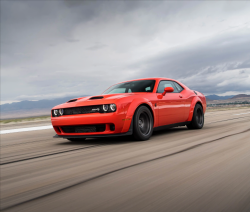The 2018 Dodge Challenger SRT Demon was truly a monster — an 840-horsepower, supercharged, purpose-built drag-racing car that could go right from the showroom floor to the drag strip and bust out 9-second quarter-mile times. It was so fast that the National Hot Rod Association banned it from its amateur competitions unless a driver installed a full roll cage. Dodge made a very limited number of them, destined to become collectors’ items in the future, if they survive until then at the hands of ham-fisted amateurs taking them to test-and-tune nights at local drag strips.
But hold on: For the 2021 model year, Dodge has come up with the new Challenger SRT Super Stock, which it’s calling the quickest, most powerful muscle car you can buy. That should come with an asterisk, then — the quickest and most powerful muscle car you can buy today, new.
Related: 2021 Dodge Challenger Super Stock: It’s No Demon, But It’s No Slouch, Either
How does Dodge boss Tim Kuniskis explain this?
“I swore that we’d never build another Demon, and we won’t,” he said in a statement. “But I also said that every Challenger Hellcat and Redeye comes with an unspoken commitment to uphold the brand, and the new Challenger SRT Super Stock is engineered to do just that.”
So the new Super Stock is technically not a Demon, and this is very true — there are some significant differences between that 2-year-old legend and the newest member of the Dodge house of muscle. Here are the five big ways in which the new 2021 Dodge Challenger SRT Super Stock is not a 2018 Demon:
1. It’s Not as Powerful
While there are some similarities between the Demon engine and the Super Stock one, the Super Stock uses a standard Hellcat Redeye engine, now a little bit more powerful and pumping out 807 horsepower for 2021. The Demon made 808 hp on plain ol’ pump gas, but if you got the special Demon Crate option, you could plug in a special engine control module that let you run 100-octane race fuel, enabling you to pump out 840 horsepower. Aside from that, much of the Demon engine still lives on in the Hellcat Redeye engine, from its stronger connecting rods to its special cooling systems aimed at keeping the engine, supercharger and intake air chilled between runs.
2. The Suspension Is Tuned Differently
The Demon had a very specific tuning to its Bilstein adjustable electronic shock absorbers, which enabled an extraordinary weight transfer to the rear wheels and actually would enable the front end to lift its wheels off the ground on a max-power launch. The Super Stock doesn’t do that — it has a more purposeful tune that still adjusts the front and rear dampers for better weight transfer to the rear wheels on a drag strip launch, but it’s not nearly as soft overall as the Demon. It should be a better-handling road car than the Demon in that regard.
3. It’s Heavier
Part of the Demon’s ultimate dragster title came from the fact that it was also subjected to a significant weight-reduction effort. It came without a front passenger seat or back bench, trunk trim, only two speakers for the audio system, and with holes punched into the firewall sound deadening — all in an effort to shave as much weight as possible from the car. The resulting Demon weighed 4,280 pounds — and while we don’t know what the Super Stock weighs just yet, the nearly mechanically identical 2021 Challenger Hellcat Widebody weighs 4,492 pounds.
More From Cars.com:
- 2018 Dodge Demon: Angel in the Seats, Devil in the Streets
- 2018 Dodge Challenger SRT Demon Review: First Drive
- 2018 Dodge Challenger SRT Demon Video
- 2018 Dodge Challenger SRT Demon Video Review
- Research the Dodge Challenger
4. There’s No ‘Super Stock Crate’
One cool feature of the Demon was that for $1 more, you could buy the Demon Crate, which included a bunch of Snap-On tools like a hydraulic floor jack, cordless impact wrench and charger, torque wrench, tire pressure gauge, fender cover and tool bag. But it also had things like a new powertrain control module for high-octane gas calibration, a replacement switch for the car that let you activate it, a conical high-flow air filter, a block-off plate for removing the passenger side mirror, and skinny front drag racing wheels and tires. The Super Stock has none of these items, which contributes to it being not quite as quick as the Demon.
5. There’s No TransBrake, Either
One of the ways the Demon was able to achieve mid-9-second quarter-miles was the very specific way you needed to launch the thing, and that included the use of something called the TransBrake. The device is a modification that locks the output shaft of the automatic transmission until it’s ready to launch, keeping the vehicle stationary through the use of the transmission paddle shifters, and eliminating the need for the driver to put afoot on the brake pedal. It improved reaction times considerably, but was tricky to use — the Super Stock doesn’t bother with it.
Cars.com’s Editorial department is your source for automotive news and reviews. In line with Cars.com’s long-standing ethics policy, editors and reviewers don’t accept gifts or free trips from automakers. The Editorial department is independent of Cars.com’s advertising, sales and sponsored content departments.
Source: Read Full Article

